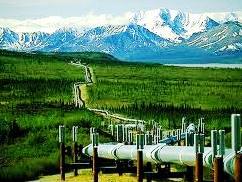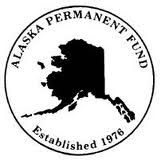» posted on Monday, July 23rd, 2012 by Linda Lou Burton
The Check’s In The Mail
 Linda Burton posting from Juneau, Alaska – Grandson Sam and I drive past the Goldbelt Building almost every day; it’s just a few blocks from our hotel, over near the Juneau-Douglas bridge. Most passers-by, like Sam and me, don’t think much about what is going on inside, where clocks are set to New York, London, Tokyo and Alaska time and the work day begins when Wall Street opens. This building houses the Alaska Permanent Fund Corporation, whose investments ultimately result in annual dividend checks for eligible Alaskans. Checks are mailed in
Linda Burton posting from Juneau, Alaska – Grandson Sam and I drive past the Goldbelt Building almost every day; it’s just a few blocks from our hotel, over near the Juneau-Douglas bridge. Most passers-by, like Sam and me, don’t think much about what is going on inside, where clocks are set to New York, London, Tokyo and Alaska time and the work day begins when Wall Street opens. This building houses the Alaska Permanent Fund Corporation, whose investments ultimately result in annual dividend checks for eligible Alaskans. Checks are mailed in  October, and last year’s dividend was $1,174. The Alaska Permanent Fund is a dedicated fund owned by the State of Alaska, created in 1976 as the Alaska oil pipeline neared completion, when Alaska voters approved a constitutional amendment to establish it. As I’ve heard residents smilingly speak of “my check,” I wondered just who the “eligible” Alaskans are, and how that dividend amount is calculated.
October, and last year’s dividend was $1,174. The Alaska Permanent Fund is a dedicated fund owned by the State of Alaska, created in 1976 as the Alaska oil pipeline neared completion, when Alaska voters approved a constitutional amendment to establish it. As I’ve heard residents smilingly speak of “my check,” I wondered just who the “eligible” Alaskans are, and how that dividend amount is calculated.
I first heard mention of the Permanent Fund from Katie, the especially kind volunteer at the Visitor Center I met last Monday. She’s the one who talked about the friendliness of Juneau, moving here in January from New Jersey. The move came about because her husband had just taken the Chief Investment Officer (CIO) position with the Permanent Fund; she explained a little about the workings of the Fund to me. The Alaska Permanent Fund Corporation manages the assets of both the Permanent Fund and other state investments, but spending Fund income is up to the Legislature. 
I’ve dug up a few more facts since meeting Katie; I’ve learned that the Fund began with an initial investment of $734,000 in 1977 and grew to approximately $38 billion as of October 2011. From 1982 through 2009, the dividend program paid out about $17.5 billion to Alaskans through the annual distribution of dividend checks.
So back to that first question – which Alaskans are eligible to receive a dividend? Start with the calendar year – you must have lived within the state a full year as of January 1. If you moved in on January 2, you have to wait until the next January 1 to start counting. And no criminal convictions! If you meet the criteria for eligibility, you then have to apply, don’t expect someone to paddle a canoe to your remote cabin and automatically bring your dividend check. And each eligible person must apply – if you’re a family consisting of one father, one mother, and three children, five separate applications must be filed; the filing period is January 1 – March 31. I’d say it’s  worth the effort; that family of five received a total of $5,870 last year. And anyone can apply online; more than two-thirds of Alaskans are doing that now. Set up an account, sign electronically, the works. Of course, paper applications still do the trick.
worth the effort; that family of five received a total of $5,870 last year. And anyone can apply online; more than two-thirds of Alaskans are doing that now. Set up an account, sign electronically, the works. Of course, paper applications still do the trick.
As to my second question, the amount of each dividend is based on a five-year average of the Fund’s performance and varies widely, depending on the stock market and many other factors. The smallest dividend was $311 per person in 1984, the largest was $3,269 in 2008. The range is generally between $900 and $1,800. The first dividend plan was to pay Alaskans $50 for each year of residency up to 20 years, but the U S Supreme Court struck that down, stating it was “an invidious distinction burdening interstate travel.” Each recipient now receives the same amount, regardless of age or years of residency.
 The payout has a substantial impact on Alaska’s economy; in rural areas where unemployment can reach 60% it’s a primary source of income. And I’m thinking about what it means to the average Alaskan family. Sam has met a boy his age here at the hotel who is traveling with his father on a work-jaunt to Juneau. Austin has six brothers and sisters back in Anchorage; as I watch the boys playing outside I’m imagining investing each child’s dividend every year till college time, how nice if Sam was receiving such a benefit!
The payout has a substantial impact on Alaska’s economy; in rural areas where unemployment can reach 60% it’s a primary source of income. And I’m thinking about what it means to the average Alaskan family. Sam has met a boy his age here at the hotel who is traveling with his father on a work-jaunt to Juneau. Austin has six brothers and sisters back in Anchorage; as I watch the boys playing outside I’m imagining investing each child’s dividend every year till college time, how nice if Sam was receiving such a benefit!
That Goldbelt Building over by the bridge is a pretty important place it seems, as what happens inside leads to those highly anticipated October words – the check’s in the mail. Or, direct deposit, if you choose.
Note: In addition to providing an annual dividend to every eligible Alaskan, the state of Alaska is the only state that levies both no state sales tax and no state income tax. (Delaware, Montana, New Hampshire and Oregon also have no state sales tax; Florida, Nevada, South Dakota, Texas and Washington also have no state income tax.)
Alaska Permanent Fund Corporation http://www.apfc.org/home/Content/aboutFund/aboutPermFund.cfm
Alaska Department of Revenue Permanent Fund Dividend Division http://www.pfd.state.ak.us/
